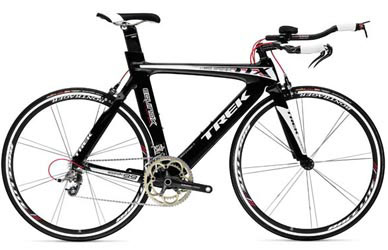

![]()
After a short stint as a component engineer, Rinard progressed to the ACG. There he could fuse his past experiences with creative input from other ACG members to address problems facing the biking industry.
One of the continual needs the ACG addresses is their consumers’ insatiable desire for speed. Rinard, a confessed acceleration addict, is more than happy to oblige. Through a process known as computational fluid dynamics, he uses algorithms to predict airflow around a bike and the drag produced by the airflow. Rinard compares the process to a “virtual wind tunnel.” “If you can make a more streamlined shape or create less drag, then the rider, for the same power, can go faster,” he says. Arguably Rinard’s most important contribution to Trek came through CFD analysis.
In 2005, when Lance Armstrong needed a time trial bike for the Tour de France, the ACG responded with the prototype Equinox TTX. Rinard was one of the engineers who ran CFD testing on the bike. On July 23, Armstrong rode the TTX to victory in the race’s final time trial stage, solidifying his seventh consecutive tour win. The win propelled the Equinox into the spotlight, becoming the envy of the triathlete community.
Three years later, the Equinox still causes heads to turn as Palac ushers it through crowds of devout triathletes. Its frame is donned with the same school bus yellow coating as the tour’s revered leader jersey. This admiration is the beauty of Trek products, their aesthetic appeal highlighting, but not overpowering, their technological prowess.
One of the individuals responsible for creating this iconic look is senior industrial designer Michael Hammond, who worked at a toy company in Dallas before coming to Trek in 2004. “We did a lot of inventing and innovating,” Hammond says. “We were trying to make the overall experience better, and it’s the same thing with bikes, as well as toys.”
Although his background in the field was limited, Hammond quickly adapted his creativity to biking. Hammond is responsible for molding the ACG’s creations into a marketable product. “We take those parts and make it look as good as it rides. It has to communicate visually what it does. It has got to look tough. It has got to look fast. It has to have all those elements to it,” Hammond says. “It can’t just be a good-riding bike, it has to be a good-looking bike too, if it’s going to capture the emotion of the customer.”
Though employees such as Hammond and Rinard provide a fertile base of creativity, ACG’s inspiration is not limited to their own mental confines. Practical application of new technology in other industries provides vital input to their bike design.
“We’ve gone to auto shows, manufacturing shows and motorcycle shows. Inspiration can come from just about anywhere,” Cusack says. “Sometimes it’s even just ideas from a plumbing catalog or something like that.” Though an immediate biking application may not present itself, Cusack makes sure to bank each novel idea he sees for possible use later.
The potential of these channels of inspiration was fully realized when Trek approached the ACG with the task of redesigning the Madone, the company’s model of excellence in road bikes. According to Trek’s website, the challenge was concise, but complicated: “Anything and everything could be questioned. The only requirements: no compromises between ride quality and weight. Merge form and function. Make it striking and make it beautiful.”
Home I Mind I Body I Soul I Site Map
About Us I Contact Us I Business Partners I Archives
Copyright 2008 Curb Magazine